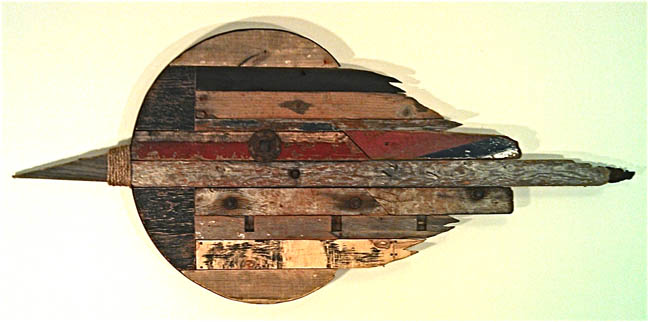

Title: Flying Spar - Shipwreck Art From Old Boats By Thomas Brigham
Shipping: $29.00
Artist: N/A
Period: Unassigned
History: N/A
Origin: N/A
Condition: Excellent
Item Date: July 2011
Item ID: 4736
Abstract assemblage "shipwreck art" made primarily from parts and pieces of old boats found in remote regions of the northern California coast. The medium consists mainly of weathered wood, heavy rusted metal, and fiber (rope, nets, etc) that are mostly found near where boat wrecks have occurred. Areas around reefs, shoals and Islands such as the Farallones tend to yield material that has been worn by the sea and sun of Marin, Sonoma and Mendocino counties. Flying Spar is a piece that is meant to connote motion or flight. Materials primarily found in counties of Marin, Sonoma and San Mateo. Very high percentage of clear boat material including teak coaming, red, white and blue piece probably from wooden hull as well as most other sections. Colors augmented by dark homemade rust/ vinegar stain. Distinctive yellow band from inner layer of weathered plywood. Piece enclosed by rusted band from Kentucky whiskey barrel. Wood is primarily redwood and teak with some weathered plywood. Large rusty bolt heads cut and removed on beaches (smaller ones packed out intact in wood).
Link: http://en.wikipedia.org/wiki/Sculpture
Sculpture is three-dimensional artwork created by shaping or combining hard and or plastic material, sound, and or text and or light, commonly stone (either rock or marble), metal, glass, or wood. Some sculptures are created directly by finding or carving; others are assembled, built up and fired, welded, molded, or cast. Sculptures are often painted. A person who creates sculptures is called a sculptor. Because sculpture involves the use of materials that can be moulded or modulated, it is considered one of the plastic arts. The majority of public art is sculpture. Many sculptures together in a garden setting may be referred to as a sculpture garden. Sculptors have generally sought to produce works of art that are as permanent as possible, working in durable and frequently expensive materials such as bronze and stone: marble, limestone, porphyry, and granite. More rarely, precious materials such as gold, silver, jade, and ivory were used for chryselephantine works. More common and less expensive materials were used for sculpture for wider consumption, including glass, hardwoods (such as oak, box/boxwood, and lime/linden); terra cotta and other ceramics, and cast metals such as pewter and zinc (spelter). Sculptures are often painted, but commonly loose their paint to time, or restorers. Many different painting techniques have been used in making sculpture, including tempera, [oil painting], gilding, house paint, aerosol, enamel and sandblasting. Many sculptors seek new ways and materials to make art. Jim Gary used stained glass and automobile parts, tools, machine parts, and hardware. One of Pablo Picasso's most famous sculptures included bicycle parts. Alexander Calder and other modernists made spectacular use of painted steel. Since the 1960s, acrylics and other plastics have been used as well. Sculptors often build small preliminary works called maquettes of ephemeral materials such as plaster of Paris, wax, or clay. Sculptors sometimes use found objects.